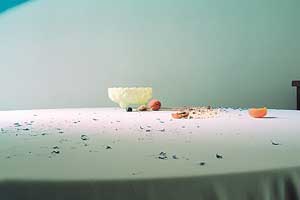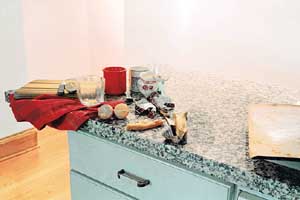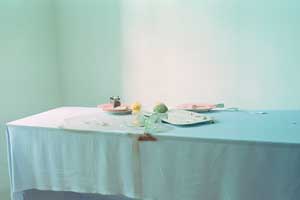Hardly More Than Ever: Letinsky interprets home as the uneasy space it can be
By Seth SandersNews Office
   From Laura Letinsky’s exhibition, “Hardly More Than Ever,” these photographs are among those that will be displayed at the Renaissance Society. From top, “Hardly More Than Ever, #80;” “Hardly More Than Ever, #66;” and “Hardly More Than Ever, #73.” | |
In a society that is sold visions of perfect meals in pristine rooms, Laura Letinsky’s photographs open one’s eyes to the aftermath of such perfection: tabletops in disarray, leftover dishes, squeezed lemons. Her new exhibition, “Hardly More Than Ever,” opening Sunday, March 7, and running through Monday, April 19, at the Renaissance Society, paints her as a sort of anti-Martha Stewart.
Letinsky, Associate Professor in the Committee on Visual Arts and the College, said her work is a way of looking at and thinking about what our lives are made of. “I’m interested in the home, the way that the domestic space is constructed or made-up. I manipulate photographic space to comment on the made-up-ness of home. The home is supposed to be a deliberate expression of who you are, but it always reflects decisions you make unconsciously as well as consciously: the color of soap you choose, a plate from a previous marriage, a glass from Ikea.”
In her photographs, table edges end in black space, tablecloths do not give quite enough visual information to tell if they are being presented horizontally or diagonally: is that cup going to fall off? “I try and set up these spaces so the sense of gravity is ambiguous—there’s not one sense of which way down is because gravity is not operating consistently across the photograph. The viewer realizes the plasticity of photographic space and the relativity of one’s point of view.” In this way, Letinsky constructs her work to make clear what is always going on.
“The camera contextualizes visual information through a monocular lens; we ourselves do not really see photographically. Photographic space is a creation, a transcription. When you exclude information, reframing what you’re seeing through the camera, you see it in ways you couldn’t see without the camera.”
Both Letinsky’s compositional techniques and the content of her pictures work toward a goal shared with much critical theory in the humanities: showing the patched-together, constructed quality of conventional things.
“Home seems a normal place, but look at all the work that goes into it. It’s not a natural space. I’m interested in that paradox about this home that’s supposedly organic and natural, that ‘just happens’ to be there, as opposed to all the work that goes into sustaining that idea in reality. It’s an uneasy space. If it’s true that the personal is political, rather than dealing with overtly political concerns, I’m seeing the home as a very politicized space.”
Her recent work follows a more overt look at the politics of the home in a series of intimate, unvarnished scenes of couples, represented in the book Venus Inferred (University Press, 2000), which contains an essay and a dialogue with Lauren Berlant, Professor in English Language & Literature and the College.
Letinsky noted that men have sometimes said they find these photographs difficult to view. “If that’s true, it may be because I tried to foreground women rather than situate it from the male point of view, putting the camera behind the woman rather than the man. The men are the more questionable figures, being looked at in an ambivalent way.”
Thematically, the “Venus Inferred” series was “not about beginning or ending but a middle place,” after people have realized “that the promise is not going to be realized. They’re post-narrative moments, after the apple has been tasted, you have knowledge, and with knowledge does not come bliss. I don’t want there to be disillusionment or complete and total abjection either; there’s a sense of the perfume of the promise wafting about along with its very elusiveness.”
By contrast, her newer work has moved from a skewed glance at one partner to a position that might come from either, or both. “The tabletop work is more possibly about getting inside the characters’ heads, so it’s more of a first-person narrative rather than a third-person viewpoint. Rather than looking at the couple, it’s looking out from their eyes.”
Letinsky received her B.F.A. from the University of Manitoba in 1986 and her M.F.A. from Yale University in 1991. She has taught at Bennington College, the Yale-Norfolk summer program and the University of Washington.
She has exhibited her color photographs in numerous venues, including the Museum of Modern Art, New York; Casino Luxembourg, The Nederlands Foto Institute; the Canadian Museum of Contemporary Photography, Ottawa; and the Museum of Contemporary Photography, Chicago.
A series of still life photographs, “Morning and Melancholia,” which is related to the Renaissance Society show, has been shown at the Edwynn Houk Gallery, New York; Copia, Napa Valley; and Stephen Bulger Gallery, Toronto.
Her other publications include Eating Architecture (MIT Press, 2003) and Blink (Phaidon Press, 2002). Her work has received support from the Illinois Arts Council, the Anonymous Was A Woman Foundation and the John Simon Guggenheim Memorial Foundation.
![[Chronicle]](/images/sidebar_header_oct06.gif)